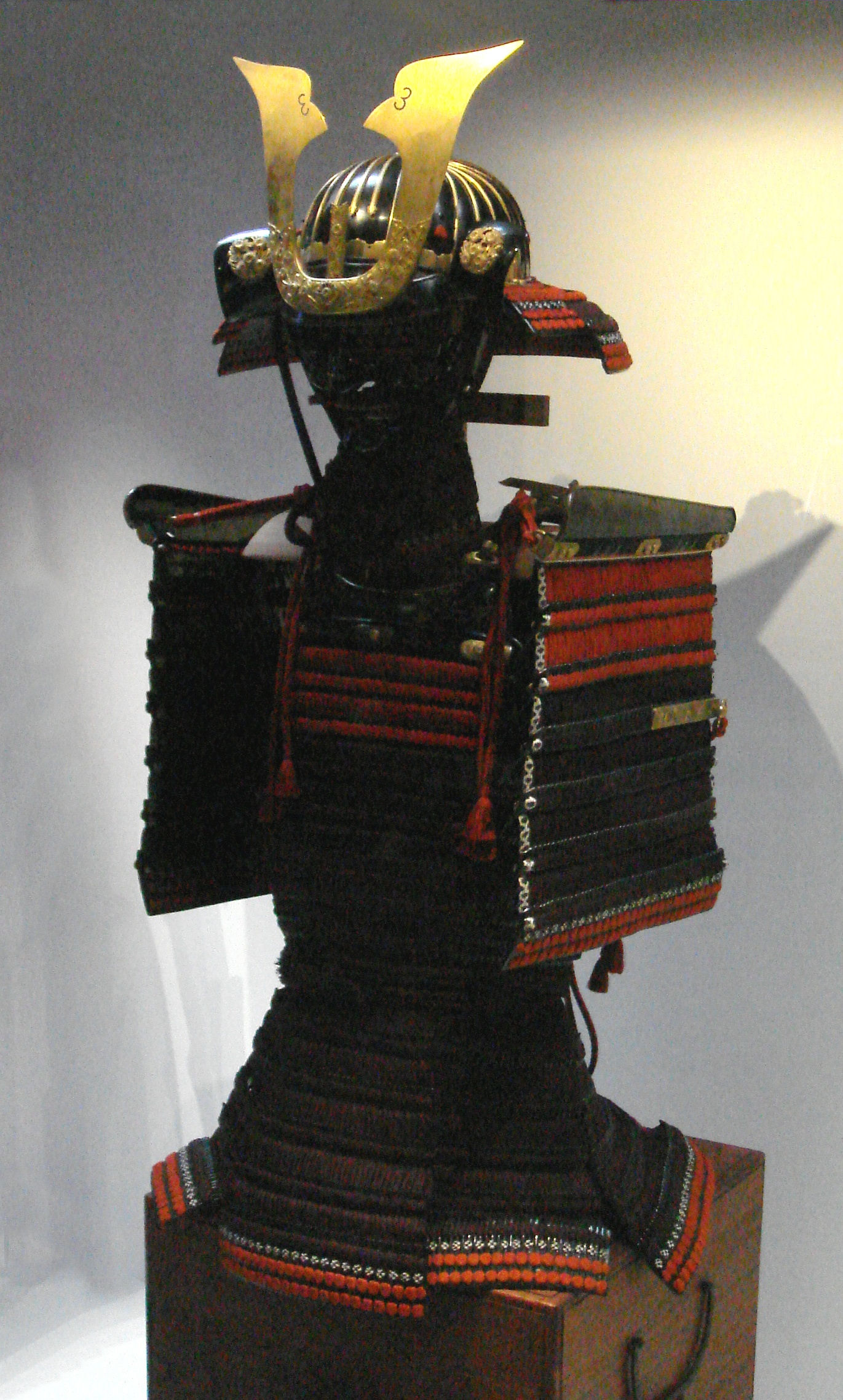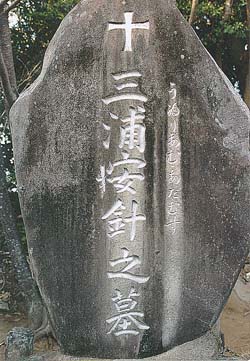Adams was treated by Ieyasu as an oracle, much to the horror
of the Jesuits, who were jealous of Adams’ influence. Adams taught Ieyasu
geometry and mathematics, acted as his interpreter and gave advice on the world
outside Japan. Prior to Adams’ arrival Ieyasu had used a Jesuit father and now
the Jesuits saw their power at court diminishing.
With his influence at court high, Adams hoped to persuade
Ieyasu to let him return to England to see his wife and daughter.
‘I
made supplication to the king [Ieyasu] to depart his lande, desiring to see my
poore wife and children according to conscience and nature……[he] was not well
pleased withal and would not let me go away more for my country.’[i]
| Monument to Adams at the sight of his former townhouse |
Concerned about Adams desire to return home, Ieyasu now gave
Adams an estate at Hemi, close to the bay at Uruga, near Edo. Adams already had
a town house in Edo. The estate[ii] encompassed several
villages and Adams now had 80-90 serfs. Sometime later Ieyasu bestowed a
Lordship on Adams, making him a hatamoto, or bannerman. No other non-Japanese
had received this honour. Shortly after this Adams discarded his European dress
and from now on wore only Japanese garb.
Adams was called by his Japanese name – Anjin (Pilot) Sama.
He gave up plans of returning to England; where his status would never reach
the dizzy heights he had achieved in Japan. Adams regularly sent letters home,
via the Dutch ships that journeyed to Japan; but the chances of getting news of
his little family was remote.
Adams married the daughter of an official, Magome Kageyu who
was responsible for a packhorse exchange on one of the imperial roads out of
Edo. As his daughter Oyuki was not of noble birth it is possible that Adams
fell in love with her. Two children were born of the marriage; Joseph and
Susannah.
The Black Ship
Every year the Portuguese merchants in Macao sent a ship[iii], laden with goods for
trading, to the Jesuit stronghold in Nagasaki. In 1609 the ship the Madre de
Dios was the most valuable to set sail for a long time. The Japanese governor
of Nagasaki sent guards to inspect the ship, but the captain refused to allow
them on board. The governor announced that he would inspect the ship in person,
but was also refused. The captain, a former governor of Macao, was one Andre
Pessoa had, a few months earlier, had a number of Japanese sailors killed in
the colony after they ran riot.
Survivors brought the news of the massacre back to Japan and
when Ieyasu heard of the disrespect offered to the governor of Nagasaki he
determined to have Pessoa and his men killed and the Madre de Dios and her
contents sequestered. Ieyasu ordered the local lord Arima Haronobu[iv] to take the ship. The
side arms of the Japanese were ineffectual against the guns of the Madre de
Dios
On the 6th January Pessoa got his ship out of the
harbour, but was intercepted by another attack from Haronobu’s men; during the
fighting a chance shot hit a grenade in the hand of one of the sailors.
Gunpowder on the ship’s deck was set alight and the sails and rigging were set
ablaze. Pessoa fired the magazine, aware that the ship was now lost. Arima
managed to salvage silver, silk, damask, brocade, gold chains and weapons.
Ieyasu was furious at the debacle, threatening to kill every
Portuguese trader in Nagasaki and exile every Jesuit in the country. He was
persuaded to change his mind, but threw his former interpreter Padre Joao
Rodrigues out of the country.
The loss of the Madre de Dios was a grave setback for the
Portuguese merchants who had invested in her cargo and reduced the Jesuit’s
prestige. The news that the Dutch from Malaya had sailed two ships into Hirado was
a blow to Portuguese hopes of retaining a monopoly on trade with Japan. The
Portuguese sent an envoy in 1611 requesting the resumption of trade, which was
allowed.
Foreign Trade
In 1609 the first Dutch ship arrived in Japan and Adams was
involved in obtaining permission for the Dutch to trade in Japan, much to the
chagrin of the Portuguese. In 1613 an English ship, of the English East India
Company[v] arrived in Hirado, where
the Dutch had set up a factory[vi]. .The leader of the
expedition John Saris was taken to meet Ieyasu by Adams and then met Hidetada. Saris
brought a letter from King James
‘We
have sent Captain General Juan Saris as our representative across the seas to
bear our greetings to the Shogun of Japan, and if it may be so that the affairs
of both our countries can thus be widely made known our satisfaction will
indeed be great.’[vii]
Suit of armour sent by Ieyasu to James I
After these two meetings Adams took Saris to stay at his
estate. Ieyasu granted the English the right to trade and wrote a reply to the
English King and sent him some gifts. Saris was determined not to be taken in
by Adams, who he believed was hand in glove with the Dutch. He failed to
realise that in Adams he had the ideal intermediary between the English traders
and the Shogunate. As a result the English factory failed to thrive in the same
way as the Dutch one and eventually in 1623, after the massacre of Amboyna[viii] withdrew to concentrate
on their holdings in India.
In 1615 Adams sailed to Ayutthaya in Siam, purchasing a
profitable cargo. He returned to Japan less than a week after the death of
Ieyasu.
Hidetada in Charge
With Ieyasu’s death in July 1616, Adams lost his patron. In
September Adams and his English fellow-countrymen presented themselves at
court. Cocks, who replaced Saris, was more inclined to respect Adams’ advice
and followed the intricate Japanese etiquette. He was rewarded with an
interview with Hidetada, who was less inclined towards foreigners than his
father. While he was willing to allow Adams to remain, Hidetada was less
favourably disposed to allow Cocks and his fellow merchants to stay. But they
were finally granted renewed trading privileges; on condition that they had no
discourse with Catholics.
Following a stay at Adams’ estate the merchants were
horrified to discover that Hidetada had issued an edict forbidding trade with
foreigners residing in Kyoto, Osaka and Sakai, where the English had
established sub-factories; the English were confined to Hirado.
In March 1617 Adams sailed to Cochinchina in a junk he
purchased second-hand. He was attempting to find two lost English factors, who had
left Hirado two years before. He discovered that the pair were dead; one
murdered and the other drowned. In 1618 he undertook another trip to
Cochinchina and Tonkin.
Death of a Pilot
Adams gravestone in Hirado
On 16th May 1620 Adams called Cocks and a
colleague to witness his last will and testament. He owned the princely sum of
£500[ix], half of which was to be
given to his family in England and the other half to his two children by Oyuki[x]. Adams died shortly after
at the age of 55, possibly from malaria[xi]
A monument to Anjin Sama is to be found in Tokyo, at the
site of his Edo town house.
Bibliography
Samurai William – Giles Milton, Hodder & Stoughton 2002
The Maker of Modern Japan – AL Sadler, Charles E Tuttle
Company 1983
Tokugawa Ieyasu Shogun – Conrad Totman, Heian 1983
En.wikipedia.org
[i] Samurai William - Milton
[iii]
All European vessels, their hulls painted with black pitch, were known in Japan
as black ships.
[iv]
Whose men had been killed in Macao
[v]
Formed in 1600 with a capital of £70,000
[vi]
The name used for the warehouse/home of the factors.
[vii]
The Maker of Modern Japan - Sadler
[viii]
The English, nine Japanese and one Portuguese were captured, tortured and
executed on the grounds that they intended to overwhelm the garrison at
Amboyna.
[ix] Worth £81,300.00 using the retail price index or £1,220,000.00
using average earnings in 2010. www.measuringworth.com
[x]
He also had a child by a maid in Hirado who was not mentioned in the will
[xi]
Picked up from a voyage to Cochinchina.


No comments:
Post a Comment
Note: only a member of this blog may post a comment.